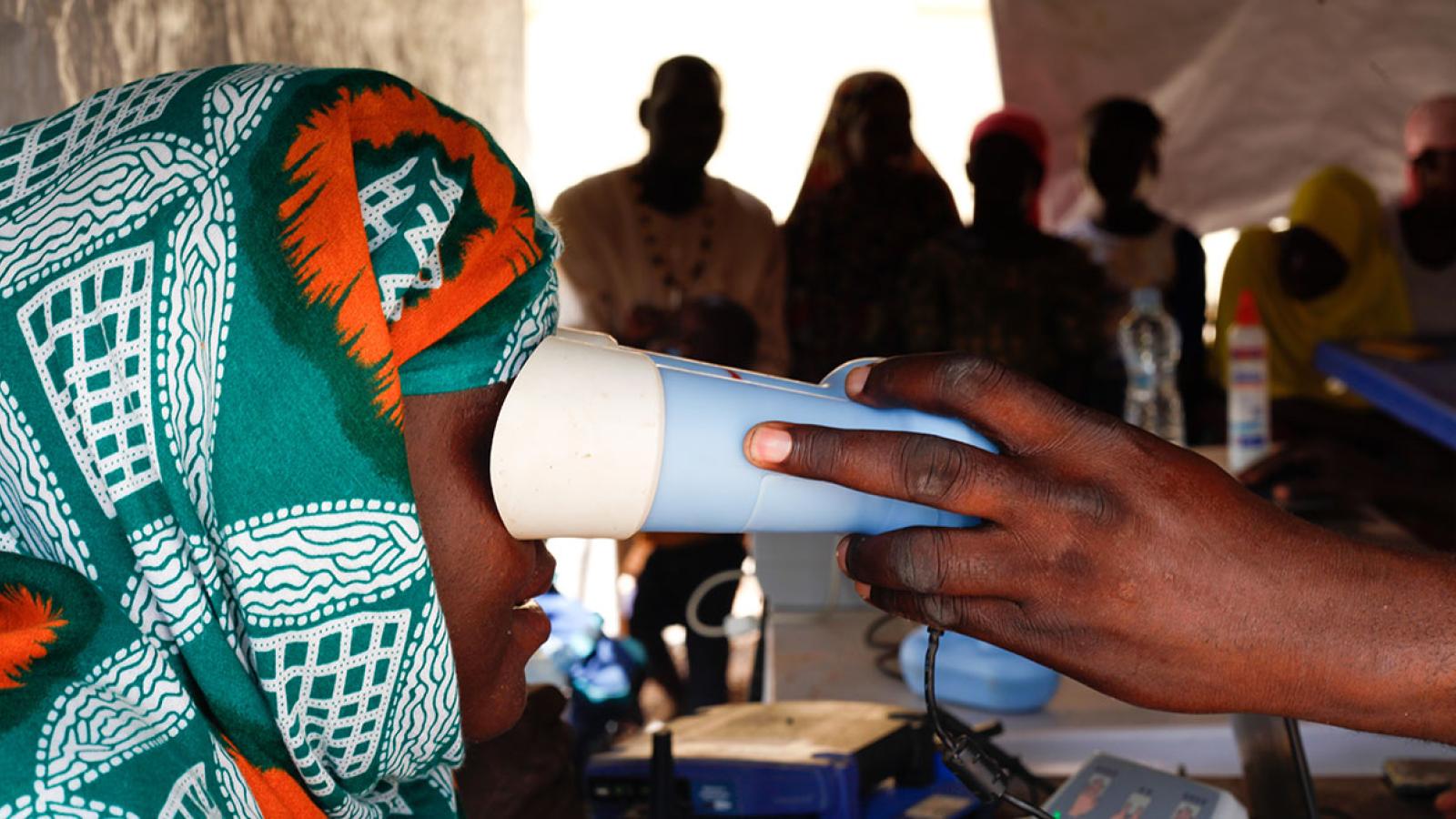How digital technologies are transforming refugees’ experiences
The latest issue of Forced Migration Review considers the double-sided nature of digital technologies and their implications for displaced people across the globe.

Iris scanning. Malian refugee being registered with UNHCR in Mauritania.
Digital technologies are transforming our lives. Forcibly displaced people are using digital technologies in ways that inform and shape their migration and settlement in new places. At the same time, digital technologies are being used on (or against) forcibly displaced people in the public and humanitarian sectors.
The diversity of digital technologies and their impacts
The ‘Digital disruption and displacement’ issue of FMR features 24 articles and covers a diverse range of topics and technologies, including complex predictive modeling, geolocation tracking on mobile phones, biometric data use and dissemination, digital financial systems and the use of artificial intelligence in decision-making. These diverse technologies span the range from promising to problematic. Often the impacts on forcibly displaced people are difficult to predict, and not easily classified as positive or negative.
In their foreword, UNHCR’s Innovation and Digital Services team highlight the opportunities of digital technologies and the dangers of not acting to ensure forcibly displaced people have equitable access to these opportunities. Jessica Bither and Jassin Irscheid of The Robert Bosch Stiftung remind us that decisions being made today will shape the digital architecture that affects the safety, privacy and agency of people on the move – and ask whether we are adequately attending to that responsibility.
Negative impacts on forcibly displaced people
The authors in this issue discuss a range of digital technologies that are used by, or on, people experiencing forced displacement. Natalie Brinham and Ali Johar describe Jafar Alam’s experience of India's digital identity system, where a tool that promised new opportunities was repurposed to facilitate persecution. Kinan Alajak and his co-authors discuss a similar shift, as migrants find the mobile phones they use on their journeys are weaponised by governments to restrict asylum, while Abril Rios-Rivera uses research on CBP One to illuminate how digital dysfunction is used to curtail asylum access.
The challenges of realising potential
Other authors address the potential and necessity of digital technologies. Lala Zinkevych discusses the use of digital tools to enable critical service delivery, describing how three digital services have offered lifelines for displaced Ukrainians experiencing gender-based violence. Wala Mohammed describes the impact of digital exclusion on displaced people in South Sudan, while Saqib Sheikh and Muhammad Noor discuss efforts to digitally preserve Rohingya cultural heritage in the context of large-scale displacement. Marie Godin and her co-authors describe how refugee-led organisations in Kenya have used digital platforms to create businesses and livelihoods, despite significant barriers.
How displaced people are co-opting and responding
Meanwhile, Nyi Nyi Kyaw complicates traditional power analyses around the use of digital technologies by describing how refugees in Thailand have used counter-surveillance, and asks whether this model could be replicated. Julia Camargo and Amanda Alencar challenge simplistic narratives about displaced people’s understanding and opinion of biometric data collection, examining responses from displaced Venezuelans.
Unequal power dynamics
Power remains a central consideration in understanding how digital technologies are used, and by whom, in relation to forced migration. M Sanjeeb Hossain and his co-authors offer a nuanced exploration of the concept of consent in relation to the biometric data of Rohingya refugees. Francesca Palmiotto and Derya Ozkul examine the strategies and resources needed to challenge government use of automated systems in migration and refugee decision-making. Carolina Gottardo and her co-authors make a compelling case for human rights safeguards to mitigate the risks presented when digital technologies are used to facilitate alternatives to immigration detention, while Steffen Angenendt and Anne Koch remind us that politics may determine the impacts of migration forecasting.
The articles across this issue of Forced Migration Review illustrate that digital technologies are not deployed neutrally. In a world where participation in digital systems is unavoidable, making those systems as equitable, unbiased, and responsive to human needs as possible will help us respond to forced displacement in ways that yield improved outcomes and greater justice for forcibly displaced people. We hope this issue contributes to such efforts.
Forced Migration Review brings together diverse, knowledgeable authors – especially those with lived experience of forced displacement – to foster practical learning and discussion that can improve outcomes for forcibly displaced people. The magazine is housed in the Refugee Studies Centre within ODID and is accessible to a global audience in English, Arabic, French and Spanish, online and in print www.fmreview.org. Dr Marie Godin and Dr Derya Ozkul collaborated with the Editors on this issue as Expert Advisors.
There will be an online launch event entitled ‘Borders, technology, and movement: Implications of technology use by states and refugees’ on Tuesday 18 June from 4-5pm, speakers:
- Derya Ozkul, University of Warwick (moderator)
- Sanjeeb Hossain, Centre for Peace and Justice, BRAC University
- Kinan Alajak, Utrecht University
- Nyi Nyi Kyaw, Chiang Mai University
Register at: https://zoom.us/webinar/register/WN_KTjE2BNpQUCadwb7MwYuwg



